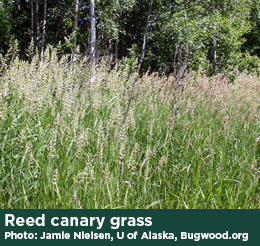Threats to Fens
 Fens and the areas surrounding them are under a number of threats, including conversion for human use, fragmentation, changes in hydrology, changes in disturbance regime, non-native invasive species, and pollution. All of these pressures mean that an already rare ecosystem needs restoration to enable it to persist.
Fens and the areas surrounding them are under a number of threats, including conversion for human use, fragmentation, changes in hydrology, changes in disturbance regime, non-native invasive species, and pollution. All of these pressures mean that an already rare ecosystem needs restoration to enable it to persist.
Conversion
The primary threat to prairie fen habitat worldwide is the direct conversion of prairie fens for agricultural use and development. Wetlands have been drained since the Middle Ages for hay production and cattle grazing, but about 60 years ago drainage technology developed further so that crop production was possible on drained wetlands, resulting in a large increase in wetland drainage. Wetlands are also drained for peat harvest to enrich garden soils and as a fuel. Although bogs are more commonly mined for peat than fens, prairie fen may be used to provide peat in areas where peat is rare. Marl in prairie fens has also been extracted to provide lime on agricultural soils, and for cement production.
Fragmentation
In addition to direct conversion of prairie fens, the landscape surrounding prairie fens in the Midwestern U.S. historically contained oak savanna and upland prairie communities. Oak savannas and prairies have been converted to agricultural land since the 1830’s. More recently these areas are being intensively developed, so that residential development neighbors prairie fen habitats and disturbance has increased in the area between prairie fens. In many cases, plant and animal species in prairie fen communities have less suitable habitat for movement to nearby prairie fens. The result in the long term may be extinction of rare species found only in prairie fen.
Hydrological changes
As groundwater-fed communities, prairie fen habitats are very sensitive to changes in the water table and water movement, known together as hydrology. Areas surrounding fens, which groundwater runs through, are known as groundwater recharge areas. Alteration of recharge areas can change the amount of water and nutrients that enter the fen system. Groundwater flow into fens can be changed by a number of activities in the uplands near prairie fens, including: quarrying, field tiling, ditching, irrigation, filling, addition of roads and parking lots, and residential development. In prairie fens with reduced groundwater input, rainwater can flush away minerals vital for plant community and soil development. Oxygen also becomes more common in soil with lowered water levels, disrupting the typically low-oxygen environment characteristic of prairie fen. Both of these changes lead to plant communities that are not characteristic of fen habitats.
Changes in disturbance
All plant communities are adapted to different levels of certain disturbance types, such as grazing, fire, flooding, or windstorms. Prairie fen and the savanna and prairie communities that surrounded them before European settlement in North America were adapted to frequent, patchy fires that burned through the areas quickly. Since the 1850’s, fire has been much less frequent in the landscape. The result is that prairie fen plant diversity has decreased in many cases, and many areas that were open, grassy areas have filled in with shrubby growth due to a lack of fire.
Non-native invasive species
Prairie fens are increasingly affected by non-native invasive plant species. The most common non-native invasive species are purple loosestrife (Lythrum salicaria), glossy (Frangula alnus) and common buckthorn (Rhamnus cathartica), narrow-leaved cattail (Typha angustifolia), common reed (Phragmites australis), and reed canary grass (Phalaris arundinacea). When these species become dominant in prairie fens, they lead to decreased diversity of the plants native to and characteristic of prairie fen.
Pollution
A variety of pollution types increasingly enter wetland systems, including chlorine and sodium from road salt, nutrients from septic tanks, herbicide runoff, and fertilizer runoff. These changes also make invasion by non-native plants more likely, and pollution leads to changes in the fen plant community.



 Print
Print Email
Email